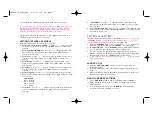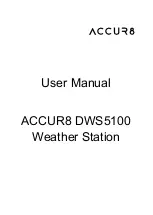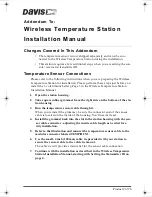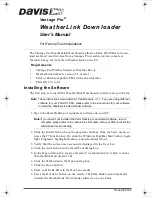
MAINTENANCE AND CARE INSTRUCTIONS
• Extreme temperatures, shock or areas of unusual vibration should be
avoided to prevent damage to the units.
• Clean the units using only a soft, damp cloth to wipe. Do not use
solvents, abrasives, detergents or other strong cleaning agents. After
cleaning, wipe surfaces with a dry cloth.
• Do not submerge units in water or other liquids.
• Do not subject the units to extremely severe temperatures - DO NOT
PLACE UNITS INTO OVENS, FREEZERS or MICROWAVE UNITS.
NOTE: Opening the housing (other than the battery compartment) of
either the Remote Sensor or the Home Unit will invalidate your warranty.
Do not attempt to repair this unit – There are no consumer serviceable parts.
TROUBLE SHOOTING
Indoor and Outdoor temperatures do not match when
placed next to each other
-
Each sensor is manufactured to be +/- 1 degree in accuracy under normal
conditions. So it is possible to have up to two degrees difference shown on
the separate temperature sensors (one could be “+1 degree” and the other
“-1 degree”. Additionally, the calibration curve is different between the two
units because of the greater temperature range of the outdoor sensor.
Errors are usually noted on the extreme ends of the temperature ranges.
Base unit is not accepting remote transmissions
-
The units may not be properly synchronized or the batteries may need to be
replaced. See “SETTING UP THE WIRELESS THERMOMETER” section
beginning on page 2 of the instructions for detailed instructions. With the
two units next to each other, attempt synchronization. Remember to always
place the remote sensor within the effective transmission range and away
from large metal surfaces.
What is the recommended battery type?
Your units will come with 4 “AA” alkaline batteries (2 “AA” batteries required
for each unit). We recommend using only alkaline batteries for replacements.
8
Where can I mount the remote sensor?
To get accurate readings and to prolong the life of your sensor, we
recommend that you mount it out of direct sunlight and rain. Fog and mist
will not affect the sensor, but large volumes of soaking rain may. To guard
against this, we recommend that you mount it under the eve of your house, your
garage or any other suitable place that will keep it out of direct sun and rain.
Modifications not authorized by the manufacturer may void users authority to
operate this device.
Note: This equipment has been tested and found to comply with the limits
for a Class B digital device, pursuant to Part 15 of the FCC Rules. These limits
are designed to provide reasonable protection against harmful interference
in a residential installation. This equipment generates, uses and can radiate
radio frequency energy and, if not installed and used in accordance with the
instructions, may cause harmful interference to radio communications. However,
there is no guarantee that interference will not occur in a particular installation.
If this equipment does cause harmful interference to radion or television
reception, which can be determined by turning the equipment off and on,
the user is encouraged to try to correct the interference by one or more of
the following measures:
• Reorient or relocate the receiving antenna.
• Increase the separation between the equipment and receiver.
• Connect the equipment into an outlet on a circuit different from that to
which the receiver is connected.
• Consult the dealer or an experienced radio/TV technician for help
SPECIFICATIONS
Range of temperature/humidity measurement:
Indoor temp :
+23 F to +122 F (-5 C to + 50 C)
Indoor humidity:
20% to 99% RH
Barometer:
900-1050 mb/hPa
Altimeter:
-100 to 2500 meters
Remote sensor:
-4 F to +140 F (-20 C to +60 C)
Channel:
max. 3 remote sensors
Transmission:
max. 100 ft. (30 m) open area, RF434 MHz
9
DWS-400-IB SPENG-REV 11/22/04 3:21 PM Page 9






























